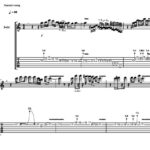The Cmaj7 Guitar chord, often written as C major 7, possesses a captivating and somewhat enigmatic quality. It’s a chord that evokes warmth yet leaves a lingering sense of openness, like an unspoken question hanging in the air. This unique sonic character is precisely why the Cmaj7 finds its place across diverse musical landscapes, from mainstream pop hits to the introspective depths of hard rock anthems.
In this lesson, we’ll guide you through learning a fundamental way to play the Cmaj7 chord on your guitar and explore some iconic songs that beautifully showcase its distinctive charm. Let’s dive in and uncover the secrets of the Cmaj7.
Understanding the Cmaj7 Chord: Notes and Theory
Before we place our fingers on the fretboard, let’s briefly explore the musical DNA of the Cmaj7 chord. It’s composed of four distinct notes:
- C (Root)
- E (Major Third)
- G (Perfect Fifth)
- B (Major Seventh)
As you progress in your guitar journey, you’ll encounter chord formulas that define major and minor chords. Seventh chords, like our Cmaj7, introduce a nuanced layer by adding a major 7th interval to the standard major chord structure. This additional note, the ‘B’ in Cmaj7, is the key ingredient that gives the chord its characteristic sophisticated and slightly jazzy flavor.
Essentially, the Cmaj7 chord expands upon the familiar C major chord by incorporating the major seventh, creating a richer and more complex harmonic texture. This added dimension is what makes the Cmaj7 so versatile and emotionally resonant.
Playing the Open Position Cmaj7 Guitar Chord (Version 1)
Now that we have a grasp of the theory, let’s translate that understanding into action on your guitar. One of the most accessible and commonly used ways to play the Cmaj7 chord is in the open position. This version, perfectly suited for standard tuning, requires just two fingers, making it a great chord for beginners to learn.
Here’s a step-by-step guide to positioning your fingers for the open Cmaj7 chord:
- Middle Finger: Place your middle finger on the 2nd fret of the D string (4th string).
- Ring Finger: Place your ring finger on the 3rd fret of the A string (5th string).
It’s important to ensure your fingers are pressing down firmly just behind the fret to get a clear sound without buzzing.
Once your fingers are in place, strum downwards across the top five strings, from the A string (5th string) down to the high E string. You should hear the full, lush sound of the Cmaj7 chord ringing out. Avoid strumming the low E string (6th string) for this voicing.
For a visual and interactive learning experience, Fender Play offers a lesson specifically for the Cmaj7 open position chord, providing further guidance and practice tools.
Songs That Feature the Cmaj7 Chord: A Melodic Journey
The Cmaj7 chord is a versatile harmonic tool favored by songwriters across genres. Its distinctive sound lends itself beautifully to a wide spectrum of musical expressions, from the introspective to the celebratory. Let’s explore some notable songs that feature the Cmaj7 chord, showcasing its diverse applications.
In the realm of alternative rock, listen for the Cmaj7 in Soundgarden’s powerful and poignant track, “Fell On Black Days”. The Cmaj7 chord subtly appears in the bridge, adding a layer of harmonic depth that amplifies the song’s emotional intensity and melancholic undertones. It demonstrates how Cmaj7 can inject a touch of vulnerability even within a heavier rock context.
Shifting gears to a more classic sound, Frank Sinatra’s timeless rendition of the holiday classic, “Have Yourself a Merry Little Christmas”, elegantly incorporates the Cmaj7. Pay close attention to how the Cmaj7 interacts with surrounding major chords like G and E, minor chords such as Em and Am, and other 7th chords including D7, G7, and E7. This song provides a masterclass in how the Cmaj7 chord can contribute to a rich tapestry of emotions within a sophisticated arrangement.
The Cmaj7’s storytelling capability shines brightly in Lukas Graham’s contemporary hit, “7 Years”. Its presence in the song enhances the narrative’s reflective and slightly bittersweet mood, perfectly complementing the lyrical themes of life and memory.
Similarly, Incubus’s introspective track “Drive” utilizes the Cmaj7 to create a sense of yearning and cautious optimism. The chord’s inherent ambiguity perfectly mirrors the song’s lyrical exploration of uncertainty and self-discovery.
Beyond these examples, you can find the Cmaj7 chord adding its unique color to songs across genres, from jazz and blues to pop and folk. Exploring songs like “Sunday Morning” by Maroon 5, “Landslide” by Fleetwood Mac, and even Radiohead’s “Creep” will reveal further instances of the Cmaj7 chord’s subtle yet powerful influence.
Continue Your Chord Journey with Fender Play
Mastering the guitar is a rewarding journey that requires consistent practice and a willingness to learn. Dedicate a few minutes each day to reinforce your chord knowledge and expand your guitar skills. Chords are the foundational building blocks of music, and learning to play them fluently unlocks a vast world of musical possibilities.
To further enrich your chord vocabulary, explore Fender Play’s comprehensive chord library. As you become more comfortable with the Cmaj7 and other essential chords, you’ll be well-equipped to tackle a wide range of songs and musical styles. Start your free trial with Fender Play today and embark on an exciting path of musical discovery.

